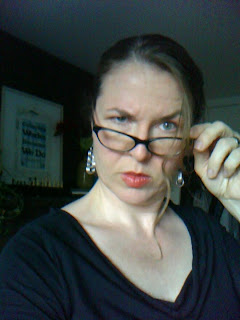This blog post provides the text of our handout and the script of our performance. Unfortunately, we do not have a video of the performance, but we included a few still photos to capture the mood. PLEASE comment on what you read and keep the conversation going!
HANDOUT:
What you will hear today is a dramatization. Except for the opening salutation, the text of this presentation is a collage of actual quotations from letters we--and our colleagues in other areas--have received in response to articles submitted to peer-reviewed publications in the field of art history. Often, the critiques that appear in those letters are unnecessarily cruel, not constructive or helpful, and motivated more by politics than true collegiality. For many specialized areas, there is also the problem of content versus method, in which reviewers are experts on a given topic but potentially prejudiced against an alternative approach to that material. In many cases, the anonymity of peer reviewing is virtually impossible given the small pool of experts in a given field. Today, we hope to draw attention to these issues by highlighting some of the withering critiques that have heretofore remained hidden away in the shameful dark corners of our file cabinets.
Here is a partial list of some blogs and websites that are bringing similar letters to light:
- http://academicfailblog.blogspot.com
- http://iheartrejectionletters.com
- http://literaryrejectionsondisplay.blogspot.com/
SCRIPT:
NANCY:
(types on a laptop)
Aaaand, send!
(pushes back from computer, sighs)
Ooh, I can’t wait to see what my peers think of my work!
MAGGIE:
(haughtily reading over her glasses, marks a paper feverishly while groaning in disdain. She then puts the paper down on the desk and picks up another sheet of paper, from which she reads)
Dear Professor Thompson,
Thank you for submitting your essay “A Postcolonial/Feminist/Ecocritical/Vital Materialist/Phenomenological Reading of Some Medieval Works of Art” to the esteemed Journal of Medieval Studies. Although none of our reviewers are familiar with the “theories” that you have explored, many of them have spent decades immersing themselves in the minutiae of the period when the works were produced. They have weighed your paper, and, unfortunately, found it to be lacking.
As you are no doubt aware, letters like this one are often comprised of a basic template, with some specific criticisms interspersed. In order to expedite the process, we have compiled a synopsis of critical comments which we hope you will find helpful:
(Actual quotes begin here:)
- On the one hand, the basic premise of the essay is both interesting and worthy of exploration, and the author brings some useful insights. On the other hand, the article as a whole is rather unsatisfying. In addition to needing the usual careful editing for grammar and typos … I find the rhetoric an odd combination of hyperbole (at the beginning) and overreliance on secondary sources (throughout) used in unsophisticated ways....I find the references to/juxtapositions with modern thought here and there annoying, but that is perhaps more a reflection of my own stylistic predilections. More seriously, the introduction of the figure of Moses is poorly done, and besides, “Medieval Codex 312” (a manuscript I know something about!) has the earliest horned Moses, not “Medieval Codex 313”, which undercuts some of the force of the essay’s rhetoric (and reliability). I may as well point out too that while perhaps Babel was associated with Nimrod as a giant, that is not what is in the picture as far as I can tell. Finally, the essay doesn’t really bring the conclusion home in any satisfying way. ....
- I'm unconvinced…
- The author's most original contributions are the speculations about the multiple meanings of [the objects]... These speculations, however, are not based on any contemporary literary sources and derive entirely from the author's imagination. I question whether this is a sufficient source for a published article.
- I believe this sort of approach has little value. It would be far better if a chronological and comprehensive review of the medieval interpretation of [the objects] was attempted. A compilation of literary sources is necessary first.
- So the argument is really a set of assertions, with 'might haves' and 'could haves' instead of evidence.
- Violation [of the manuscript] begets a certain type of empathy? But this should not be confused with scholarship.
- The author needs to consider the possibility that visual similarities might reveal workshop links, (or, alternatively, common doctrinal/theological preoccupations)
- Professor Thompson needs to read the most important dissertation in this area, a recent work by.... Nancy M. Thompson.
- the work lacks the necessary scholarly apparatus
- the essay is methodologically unsophisticated
- You seem to cherish a sentimental attachment to your object of study that is distracting at best and, taken at its worst, conveys a lack of the critical distance necessary for a serious academic study
- the author comes across as overly earnest
- Most problematic, however, is the author's assumption that all her readers are Christians -- or even all Protestants since she dumps on Catholics, too. This is deeply offensive to all her academic readers. ... Finally, the topic, although a woman writer [sic], does not cover issues of gender or women's place.
- ...perhaps, but I remain unconvinced.
In conclusion, one of our editors would like to add that she is very sorry, not least because she’s devoted a tremendous amount of her own time and effort to get your paper to where it is, and she hopes this won't discourage you from submitting other work.
I’m sorry to say that we have decided not to publish the paper, although we did enjoy reading it.
Sincerely,
The Editors



No comments:
Post a Comment